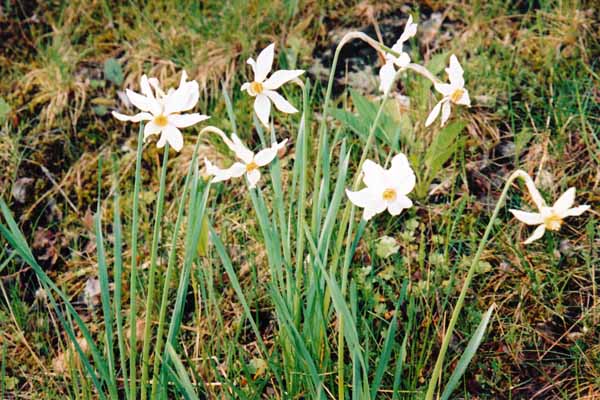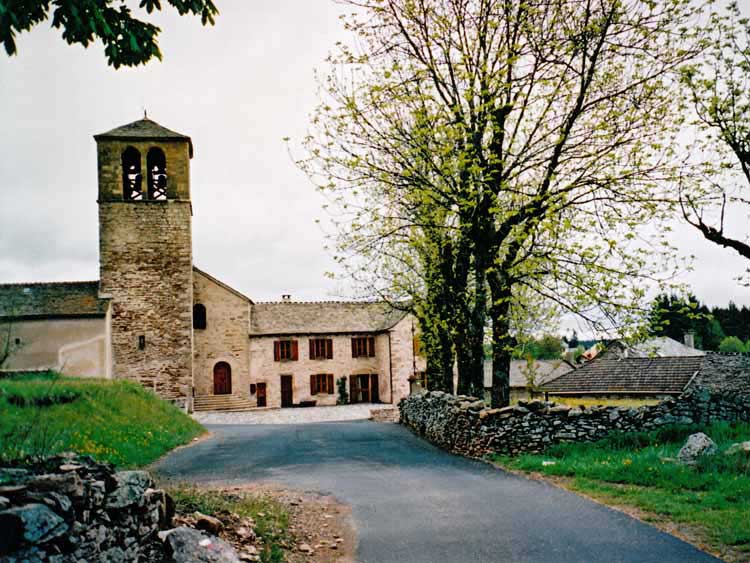Tuesday, 1 June 2004
Distance 23 km
Duration 5 hours 55 minutes
Ascent 635 m, descent 579 m
Map 59 in the TOP 100 blue series (now superseded)
Topoguide (Ref. 700) le Chemin de Stevenson

There was an unseemly display of pinching and punching for the first of the month before we rose at 7:30, much later than usual because of the comfort of the bed. I wanted to have another shower but I was afraid to moisten and soften my blisters any more than necessary.
We went to take our leave of the curly-whiskered elf and his wife, and to thank them for the dinner, which had been cooked by him and served by her. I explained that we were late because we had slept too well, which they took as a great joke and a compliment.
Our intention was to go to the abbey of Our Lady of the Snows, but they told us it did not open till 10 o’clock, which was too late for us, as it was no more than an hour’s walk away.
So we added it to our list of places to visit when we come round in a sports car after our legs give way, and set off.

We took a quiet road gradually ascending along the Allier instead of the more uphill and roundabout GR. This was because of the state of my feet, which were torturing me and reducing my progress to a hobble.
The most memorable thing about the morning, apart from my blisters, was the drifts of pale daffodils as thick as snow on either side of the road. Beyond the meadows, the river tumbled in rapids and pools through arcades of birches.
We covered ten or twelve kilometres of this lovely country, with me struggling along in the rear, before we arrived at the railway station of Chasseradès.

At the old inn, looking out onto what surely must be a snowy plain for most of the year, we sank gratefully into chairs on the glassed-in terrace.
My poor feet seemed to swell like yeast buns when I took off my boots.
The coffee, the cheerful radio and the shelter from the cutting wind were all intensely enjoyable.
It was here that Robert Louis stayed, in the company of a group of men surveying for the new railway line, whom he found “intelligent and conversible, and we decided the future of France over hot wine, until the state of the clock frightened us to bed”.
The railway line, long completed, snaked away in front of us with its wooden casings to keep off the worst of the snow.

From here it was only a short walk into the village proper, wedged into a fold of land out of the wind.
We marched straight through and up to the church, where the icy wind hit us and sent us smartly back to the nearby café for a second round of coffees. The barman turned on the TV for us to see la Météo and we found out that the weather was improving and we would soon see the sun again.
This time we did manage to brave the wind and made our way, Keith striding, I creeping along behind, down to the deep gulch where Mirandol crouches like a mouse under the elephantine legs of the railway viaduct.

Up the other side, a delightful flower-edged path took us through l’Estampes and out again, still climbing. This mountain mass is known as the Goulet.
The GR then took one of its classic short-cuts, scrambling up in the forest to cut off a mile or so of the road.
It was a deciduous forest and the path was as deep and springy as a mattress with brown leaf-litter.

Back on the road, we soon parted from it again, but not on the GR. We had seen a better way on the map, following forestry tracks straight down to les Alpiers. But first we had lunch sitting inside a cloud on a log in a clearing of the forest.
All the pine forests in these mountains have been planted since the death of the transhumance, the traditional summer pasturing of stock in the high meadows.
We rejoined the GR at les Alpiers, an erstwhile centre of the transhumance, and descended quickly to le Bleymard at the bottom of the valley. We had seen the first trickles of the Lot river in the forest above les Alpiers and we met it again as a gushing stream at le Bleymard.

Our first sight of the town was not encouraging – an ugly metal supermarket, a school and a double row of shops and bars, all closed. It was the siesta hour, and drizzling.
Fortunately the travellers’ inn at the edge of town, the la Remise, was functioning, its lights twinkling in the dampness. We had our usual grands crèmes in this cosy place and made sure that we would be able to dine there in the evening.
At the nearby camping area, there were several groups of cyclists and walkers in small tents like ours, but nobody to take our money of course. We had to be quick putting up the tent because of the rain, which was light but persistent.

We only had time for a short rest before returning, clad in raincoats, to the hotel for apéritifs.
As we were drinking, Keith realised he had left all our documents, cards and money lying loose in the tent, and had to dash back and retrieve them.
Dinner was served in the graceful old dining room. Most of the diners were hearty foreigners like ourselves and we all had the €12 menu – a salad to start with, then a pot au feu with rice, a platter of cheeses and finally a crème caramel.
A very young waiter in a tuxedo wanted to practise his English. He said “You wish to pay with the blue card?” and we knew exactly what he meant, after the drama at the Gare de Lyon a fortnight before.
Previous section: Le Puy-en-Velay to la Bastide-Puylaurent